Green pass: goals, limits and obstacles. Gimbe Report

Green pass: the analysis of the Gimbe foundation chaired by Nino Cartabellotta
In this phase of the pandemic, the green pass can play a crucial role: it is effective in limiting the circulation of the virus and allows the safe relaunch of certain sectors, preventing the risk of a return to any restrictions. In the short term, the use of the green pass collides with some obstacles that must be removed: the current unavailability of vaccines discriminates against those waiting for vaccination, also due to the lack of free tampons in various Regions; tools and resources are needed to systematically verify certifications in the places where they are required; there is no law on the vaccination obligation for those who work in clubs and businesses where the green pass is required.
This is what the Gimbe foundation chaired by Nino Cartabellotta reveals: "It can have an immediate application for major events (sports, music, trade fairs, congresses) and means of transport (airplanes, ships and long-distance trains), possibly also for cinemas and theaters; but in the short term its use for restaurants and especially bars is more complex. On the other hand, its implementation is more difficult for local transport and other essential services (e.g. supermarkets, pharmacies, etc.) – we read in an analysis of the foundation – The ventilated hypothesis of modulating the green pass in relation to vaccination status (previously dose or complete cycle) and / or to the colors of the Regions introduces further elements of complexity that are difficult to manage in practice ".
Here is the updated report of the Gimbe foundation on the vaccination campaign in Italy:
The independent monitoring of the Gimbe Foundation detects in the week 14-20 July 2021, compared to the previous one, an increase of 115.7% in new cases (19,390 vs 8,989) (figure 1), while deaths are still decreasing (76 vs 104) (figure 2). After more than three months of decrease, there is a reversal of the trend of currently positive cases (49,310 vs 40,649), people in home isolation (47,951 vs 39,364), hospitalizations with symptoms (1,194 vs 1,128) and intensive care ( 165 vs 157) (figure 3). In detail, compared to the previous week, the following changes were recorded:
- Deaths: 76 (-26.9%)
- Intensive care: +8 (+ 5.1%)
- Hospitalized with symptoms: +66 (+ 5.9%)
- Home isolation: +8,587 (+ 21.8%)
- New cases: 19,390 (+ 115.7%)
- Currently positive cases: +8,661 (+ 21.3%)
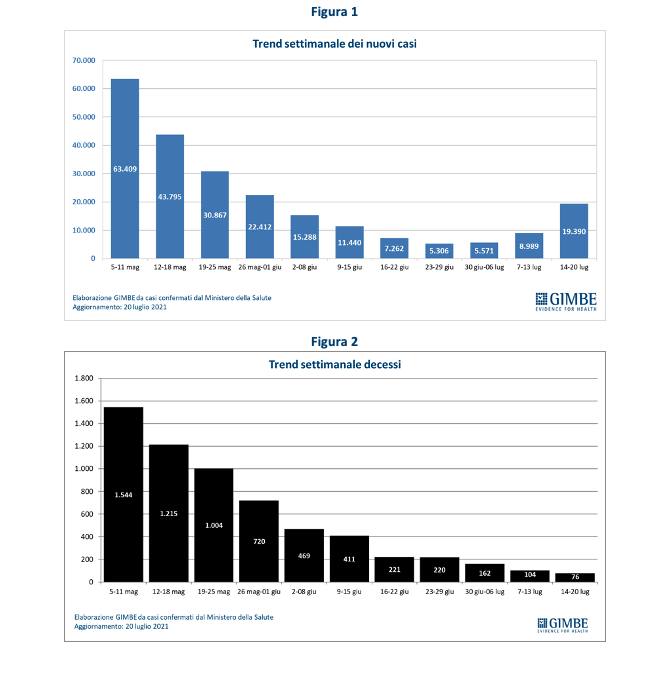
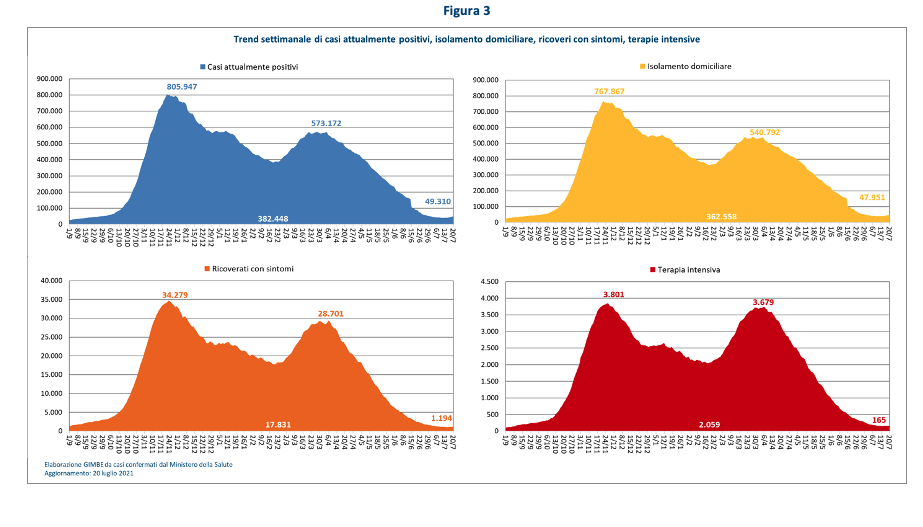
"On the front of new cases – declares Nino Cartabellotta, President of the Gimbe Foundation – there is a net weekly increase, probably underestimated by insufficient testing and the failure to resume contact tracing, now made more difficult by the increase in positives . In the week 14-20 July in all Regions there is a percentage increase in new cases compared to the previous one (table 1) and there are 51 Provinces in which in the last 14 days there is a weekly increase in new cases of more than 20% and which in the last seven days have registered an absolute value of at least 50 new cases (table 2). Deaths continue to drop, 76 in the last week, with an average of 11 per day compared to 15 in the previous week.
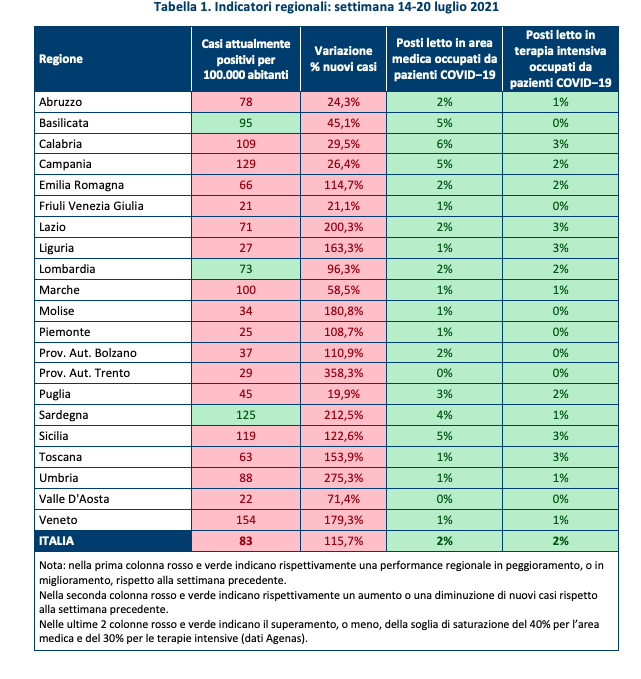
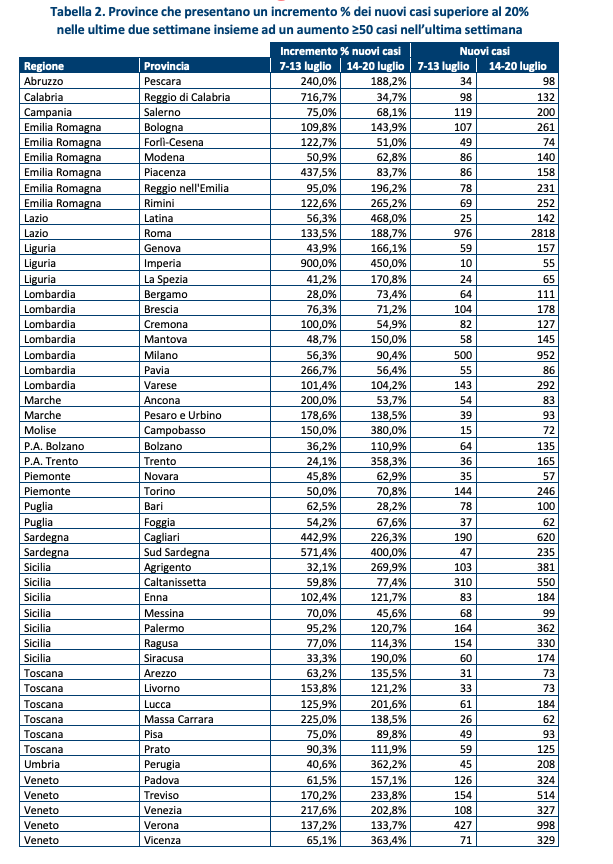
"After 14 weeks of reduction in hospital indicators – says Renata Gili, Head of Research on Health Services of the Gimbe Foundation – there is a reversal of the trend with a slight increase in hospitalizations in the medical area and in intensive care, where the occupation of beds on the part of Covid patients remains very low for now, around 2% ». All Regions record values of less than 10% for the medical area and 5% for intensive care: 7 Regions that do not count Covid patients in the critical area. "A further slight increase is confirmed – explains Marco Mosti, Operations Director of the Gimbe Foundation – in daily admissions to intensive care: the 7-day moving average is 10 admissions / day compared to 7 in the previous week" (figure 4).
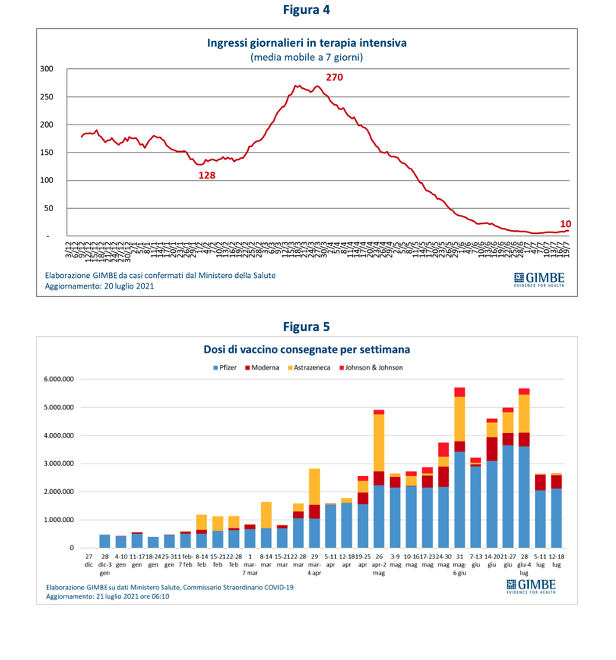
Vaccines: supplies.
As of July 21 (update 6.10), 66,462,630 doses were delivered: after the peak of deliveries of the week June 28-July 4 (5,669,727 doses), in the following two weeks the weekly supplies stood at around 2.6 millions of doses (figure 5). Even without the failure to update the expected deliveries (latest update: April 23) it is realistic to predict that only mRNA vaccines will arrive in the third quarter, given the imminent sunset of the adenoviral vector vaccines and the failure of CureVac to pass clinical tests ( figure 6).
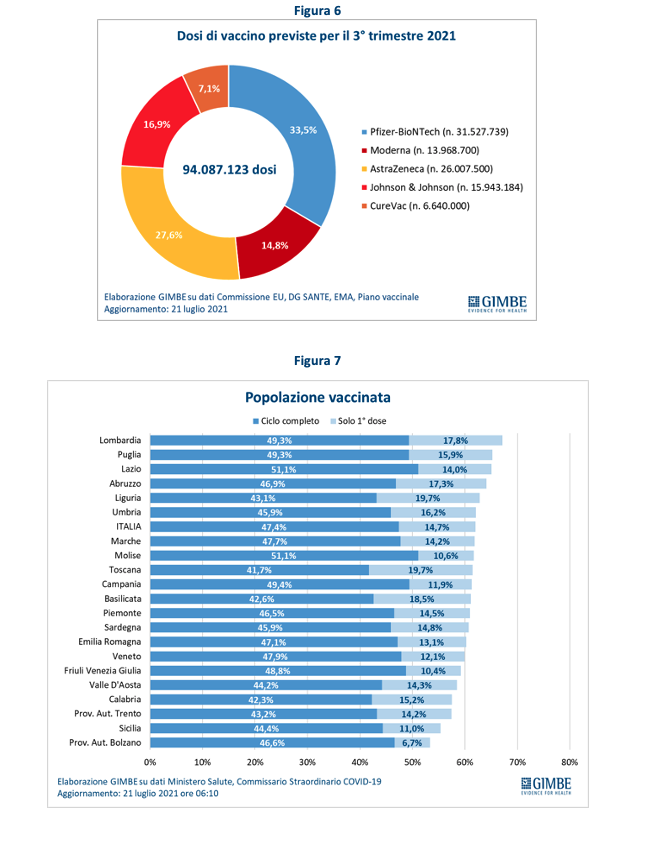
Vaccines: administrations.
As of July 21 (update 6.10) 62.1% of the population (n.36.767.656) received at least one dose of vaccine (+724.981 compared to the previous week) and 47.4% (n.28.072.581) completed the vaccination cycle (+3.270.882 compared to the previous week) (figure 7). The number of administrations was also stable in the last week (3,857,622) (figure 8), with a 7-day moving average of 549,282 inoculations / day (figure 9).
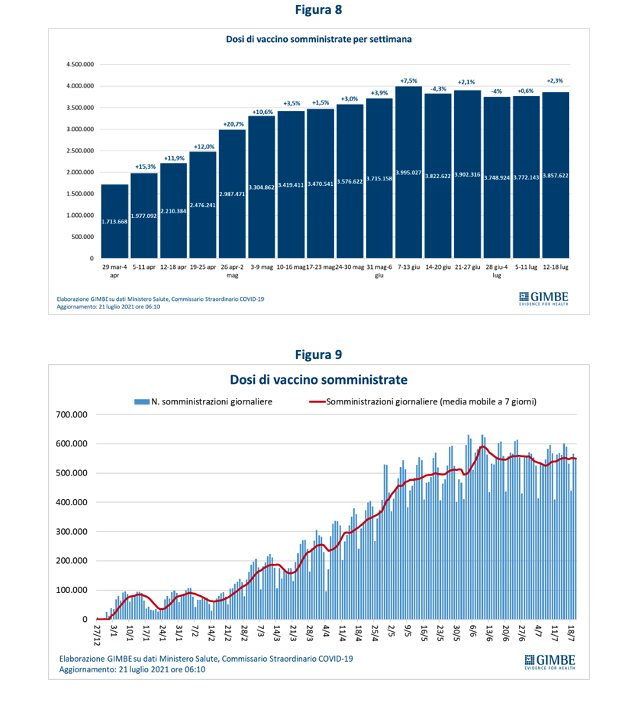
"The number of daily administrations – specifies Cartabellotta – has been stable for weeks now despite the organizational potential, due to the lack of use of adenoviral vector vaccines and the limited availability of mRNA ones". In particular, AstraZeneca is no longer administered for the first doses, as evidenced by the fact that in the last week 99.3% of the administrations were boosters; Johnson & Johnson's administrations are now sporadic (in the last week on average 3,000 per day); finally, we do not have a sufficient number of doses of mRNA vaccines to expand the range of vaccinators. "In this scenario – explains Mosti – the percentage of first doses on the total doses administered continues to drop: from over 2.9 million first doses of the week 7-13 June (74% of the total) they fell to 583 thousand in the week July 12-18 (15% of the total), with an overall reduction of 80.3% "(figure 10).
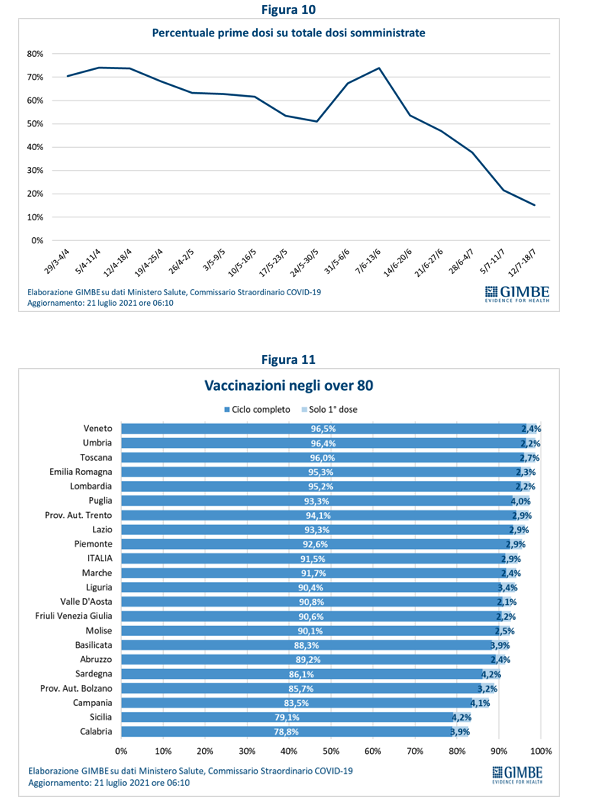
Vaccines: coverage of over 60s.
88% received at least one dose of vaccine, with a negligible weekly increase at national level (+ 0.4%) and clear regional differences: while Puglia, Umbria, Lazio, Lombardy and Tuscany exceeded 90%, Sicily remains steady at 79%. In detail:
- Over 80: of the over 4.4 million, 4,098,799 (91.5%) completed the vaccination course and 132,157 (2.9%) received only the first dose (Figure 11).
- Age range 70-79: of the over 5.9 million, 4,781,739 (80.2%) completed the vaccination course and 513,802 (8.6%) received the first dose only (Figure 12).
- Age range 60-69: of the over 7.3 million, 5,061,234 (68%) completed the vaccination course and 1,144,838 (15.4%) received the first dose only (Figure 13).
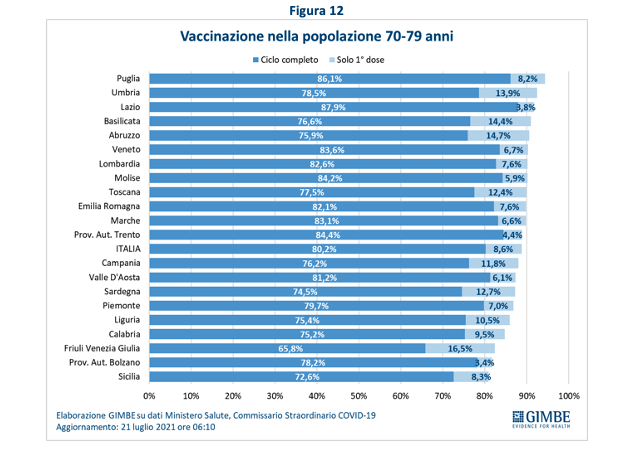
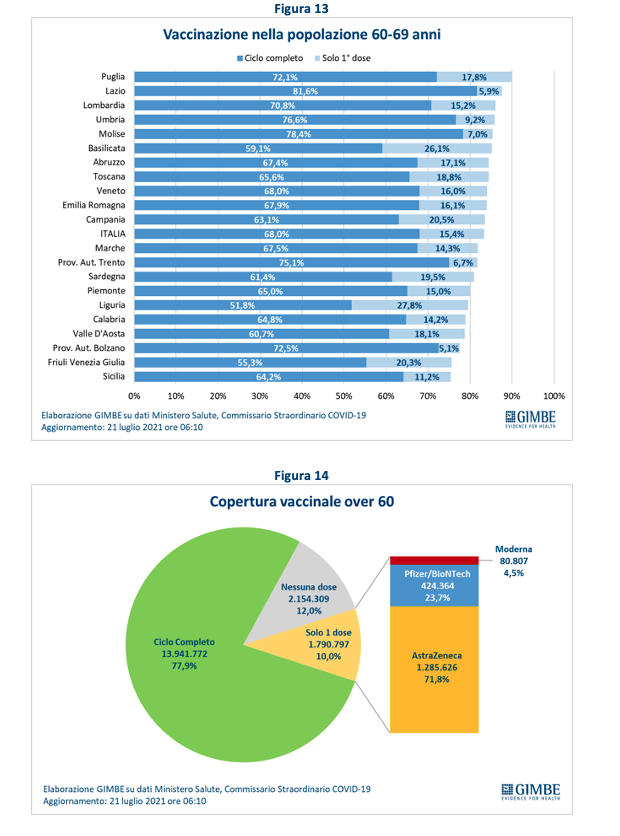
Delta variant.
Faced with the spread of this variant which is about to become prevalent, the almost 4 million over 60s at risk of serious illness not covered by the double dose of vaccine continue to worry (figure 14). In detail: 2.15 million (12%) have not yet received even a dose with significant regional differences (from 21% in Sicily to 6.9% in Puglia) (figure 15) and 1.79 million (10%) are waiting to complete the cycle with the second dose. "The increase in coverage compared to last week – points out Gili – is almost exclusively linked to the completion of vaccination cycles: in other words, the number of over 60s who receive the first dose continues to stagnate, a sign of persistent vaccination hesitation in this age range". Moreover, the trend of administration of the first doses by age group confirms the flattening of the curves of the over 80s and the 70-79 and 60-69 groups and a decline for all the other age groups (figure 16), with considerable differences in coverage between the various personal data classes (figure 17).
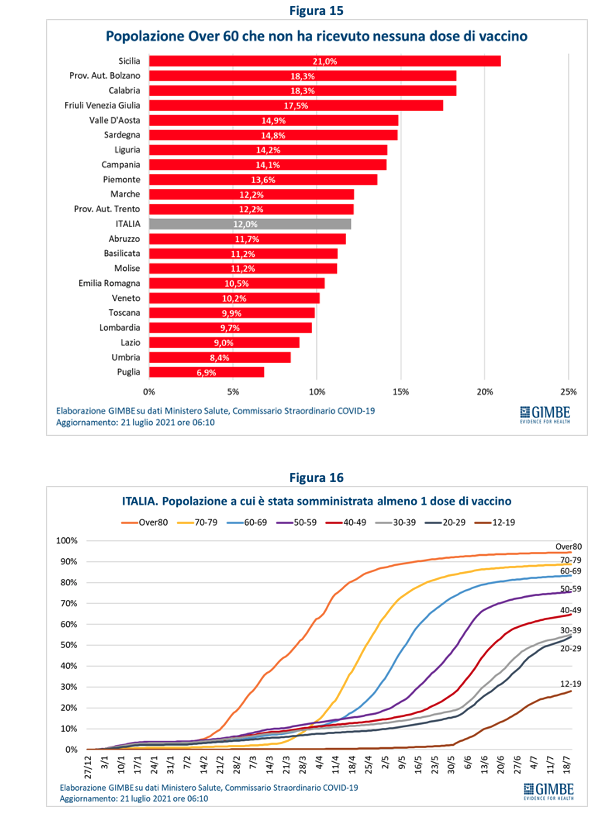
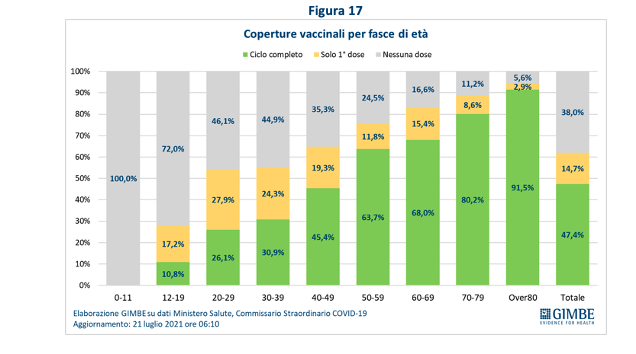
Green pass.
"In the heated debate on the possible uses of the green pass in Italy – says Cartabellotta – clouded by extreme political positions, unacceptable and opportunistic distortions of scientific evidence and national data on the efficacy of vaccines published by the Istituto Superiore di Sanità e di safety published by Aifa ». The GIMBE Foundation reiterates its position on the green pass, urging political forces not to further polarize the extremes on the use of a tool that:
- In this phase of the pandemic, the green pass can play a crucial role: it is effective in limiting the circulation of the virus and allows the safe relaunch of certain sectors, preventing the risk of a return to any restrictions.
- In the short term, the use of the green pass collides with some obstacles that must be removed:
-
- The current unavailability of vaccines discriminates against those waiting for vaccination, also due to the lack of free tampons in different Regions
- Tools and resources are needed to systematically verify certifications in the places where they are required
- There is no law on the vaccination obligation for those who work in clubs and businesses where the green pass is required
- It can have an immediate application for large events (sports, music, trade fairs, congresses) and means of transport (airplanes, ships and long-distance trains), possibly also for cinemas and theaters; but in the short term its use for restaurants and especially bars is more complex. On the other hand, it is more difficult to implement it for local transport and other essential services (eg supermarkets, pharmacies, etc.).
- The ventured hypothesis of modulating the green pass in relation to the vaccination status (first dose or complete cycle) and / or the colors of the Regions introduces further elements of complexity that are difficult to manage in practice.
Modify color assignment parameters Regions.
While on the one hand it is reasonably certain that, compared to previous waves, the increased circulation of the virus will have a lower impact on hospitals thanks to the vaccination coverage of the over 60 and frail, on the other hand to entrust an excessive (or even exclusive) weight to the indicators hospital to "color" the Regions realizes an "uncalculated risk" for three reasons.
- It makes you lose sight of the monitoring of the circulation of the virus, the extent of which however has a hospital impact proportional to its spread.
- It is a less timely indicator as the hospitalization curve follows that of new cases with a certain delay.
- The introduction of any restrictive measures would be late and would produce an improvement only after a few weeks.
"If the Government and the Regions intend to abandon the parameter of infections – concludes Cartabellotta – very low thresholds are needed for hospital indicators: no more than 5% of employment by Covid-19 patients for intensive care and 10% for hospitalizations in medical area to stay in the white zone. If, on the other hand, the intention is to raise these thresholds, in addition to accepting the risks described above, the number of cases per 100,000 inhabitants must be kept among the monitoring parameters, increasing the weekly incidence above 50 cases to preserve the white and defining a standard number of tampons per 100,000 inhabitants to avoid opportunistic behavior ».
This is a machine translation from Italian language of a post published on Start Magazine at the URL https://www.startmag.it/sanita/green-pass-fini-limiti-e-ostacoli-report-gimbe/ on Thu, 22 Jul 2021 08:07:50 +0000.
